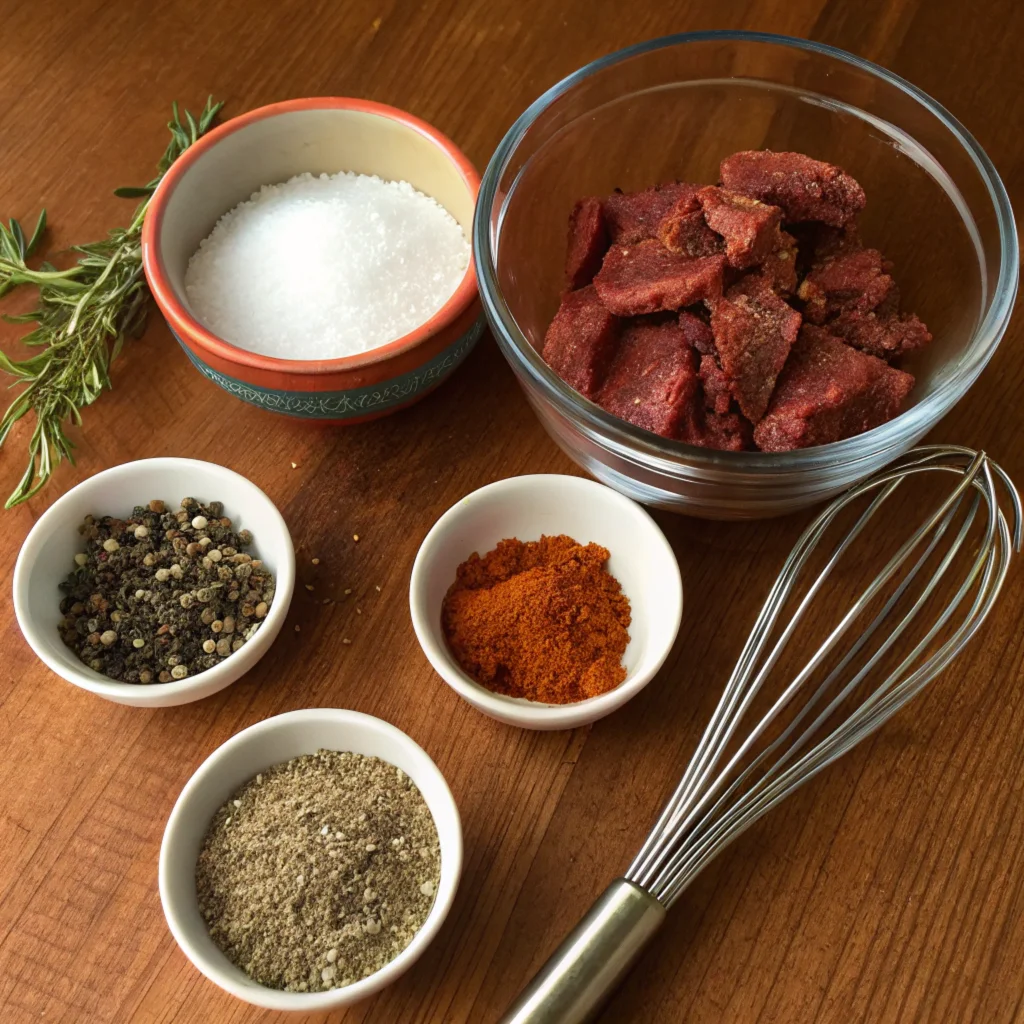Introduction to Beef Stew Seasoning Recipe
When it comes to crafting the perfect beef stew, the seasoning plays a pivotal role in bringing out the rich, hearty flavors. The ideal beef stew seasoning recipe combines a variety of spices and herbs, creating a harmonious blend that enhances every bite. Whether you’re preparing a quick weeknight meal or a slow-cooked Sunday dinner, mastering your seasoning ensures your beef stew is always flavorful and satisfying.
In this guide, you’ll learn why homemade seasoning is superior, the essential ingredients you need, and how to make and store your seasoning for ultimate convenience. Let’s dive into the details!
Interested in Beef Dishes! Discover What is the Most Popular Beef Dishes?
Why Homemade Beef Stew Seasoning Is the Best Choice
Choosing a homemade beef stew seasoning recipe over store-bought blends offers numerous benefits:
- Customization: Adjust the spice levels, salt content, and herb combinations to suit your taste.
- Freshness: Homemade blends ensure you’re using fresh spices, which significantly enhances flavor.
- Healthier: Store-bought options often include preservatives, artificial flavors, and excessive sodium.
- Cost-Effective: Creating your blend saves money compared to buying prepackaged options.
Moreover, homemade seasoning allows you to experiment with flavors, ensuring every bowl of stew feels personal and unique. Once you try it, you’ll never go back to prepackaged mixes.
Essential Ingredients for Beef Stew Seasoning
Crafting a perfect beef stew seasoning recipe requires a thoughtful combination of spices and herbs. Here are the must-have ingredients:

- Salt: Enhances the natural flavors of the beef and vegetables.
- Black Pepper: Adds depth and a subtle heat.
- Paprika: Brings a mild sweetness and vibrant color.
- Garlic Powder: Delivers robust, savory undertones.
- Onion Powder: Adds a layer of sweetness and aroma.
- Dried Thyme: Provides earthy, herbal notes that complement beef.
- Bay Leaf (optional): Offers subtle bitterness for a balanced flavor.
- Red Chili Flakes: Adds a hint of spice for those who enjoy the heat.
Feel free to tweak the proportions or add other spices like cumin or rosemary for a personal touch.
Step-by-Step Guide to Making Beef Stew Seasoning
Making a beef stew seasoning recipe at home is simple and rewarding. Follow these steps to create your custom blend.
Step 1: Gather and Measure Ingredients
Before starting, ensure you have all the necessary ingredients:
- 2 tablespoons salt
- 1 tablespoon black pepper
- 1 tablespoon paprika
- 1 tablespoon garlic powder
- 1 tablespoon onion powder
- 1 teaspoon dried thyme
- Optional: ½ teaspoon red chili flakes or a pinch of cumin for added flavor
Tip: Use high-quality spices for the best results. Freshly ground spices offer more intense flavor than pre-ground options.
Step 2: Mix the Ingredients Thoroughly
- Place all the measured spices into a mixing bowl.
- Use a whisk or spoon to combine them evenly.
- Check for consistency to ensure no clumps remain.
This step ensures every spoonful of your seasoning delivers a balanced flavor.
Step 3: Store in an Airtight Container
- Transfer the blend to a clean, dry, airtight container.
- Label the container with the date to keep track of freshness.
- Store in a cool, dark place to preserve flavor for up to 6 months.
Proper storage is crucial for maintaining the potency of your homemade beef stew seasoning recipe.
How to Use Your Beef Stew Seasoning
Incorporating your beef stew seasoning recipe into your cooking process is straightforward and incredibly rewarding. Here’s a detailed guide to ensure your stew is packed with flavor at every step.
Marinate the Beef for Enhanced Flavor
Before cooking, take your beef chunks and rub them generously with the seasoning blend. This step allows the spices to penetrate the Meat, creating a deep, savory taste. The salt in the mix helps tenderize the beef, while the herbs and spices infuse it with rich, aromatic notes.
- Allow the beef to marinate for at least 30 minutes. For a more intense flavor, consider letting it rest for a few hours in the refrigerator.
- If you’re short on time, even a quick coating of the seasoning before browning can make a noticeable difference.
By seasoning early, you ensure the beef carries bold flavor throughout the cooking process.
Add the Seasoning to the Cooking Liquid
The secret to a flavorful stew lies in the broth, as it ties together all the ingredients. Add 2–3 tablespoons of your homemade beef stew seasoning recipe directly to the cooking liquid. This ensures every spoonful of broth is infused with the perfect balance of spices and herbs.
- Stir the seasoning into the broth at the beginning of the cooking process for maximum infusion.
- For slow cookers or pressure cookers, mix the seasoning into the liquid before starting the cooking cycle.
The spices will meld with the juices from the beef and vegetables, creating a hearty, flavorful base for your stew.
Adjust Seasoning Levels Gradually
As the stew cooks, taste the broth periodically to adjust the flavor. While the initial amount of seasoning provides a solid base, additional seasoning may be needed to achieve your desired taste. This is especially important if you add more ingredients, such as extra vegetables or liquids.
- Start by adding small amounts, such as ½ teaspoon at a time, to avoid over-seasoning.
- Stir well after each addition and allow the flavors to blend for a few minutes before tasting again.
This method ensures a balanced, well-seasoned stew without overpowering any single ingredient.
Use as a Finishing Touch
For an extra flavor boost, sprinkle a pinch of the seasoning onto the stew just before serving. This step heightens the aroma and adds a fresh, vibrant layer to the dish. It’s particularly effective if your seasoning contains fragrant herbs like thyme or parsley.
- Serve the stew hot, with the seasoning as the final touch.
- Pair with crusty bread or a side of rice to soak up the flavorful broth.
By incorporating your seasoning at multiple stages, you create a multi-dimensional flavor profile that makes every bite unforgettable. This approach ensures your beef stew seasoning recipe becomes an integral part of your signature dish.
Tips for Making the Best Beef Stew with Homemade Seasoning
To elevate your beef stew, follow these expert tips:
- Sear the Meat First: Browning the beef locks in flavor and adds a caramelized richness.
- Use Fresh Vegetables: Carrots, potatoes, and celery absorb the seasoning, enhancing the overall dish.
- Cook Slowly: Simmering the stew on low heat allows the spices to infuse thoroughly.
- Taste as You Go: Adjust seasoning levels gradually to avoid overpowering the stew.
- Don’t Skip the Bay Leaf: While optional, it adds a subtle complexity to the broth.
With these tips, your beef stew will be nothing short of perfection.
Variations of Beef Stew Seasoning Recipe
Customizing your beef stew seasoning recipe allows you to explore different flavor profiles. Here are some popular variations:
Spicy Version
- Add one teaspoon of cayenne pepper for extra heat.
- Increase red chili flakes to 1 teaspoon.
- Include a dash of smoked paprika for a bolder kick.
Herb-Forward Blend
- Double the amount of dried thyme.
- Add one teaspoon of dried rosemary and one teaspoon of parsley.
- Use a pinch of marjoram for a unique twist.
Low-Sodium Option
- Replace regular salt with a salt substitute or reduce salt by half.
- Enhance flavor with garlic powder, onion powder, and herbs.
- Add a splash of Worcestershire sauce when cooking for depth.
Beef Stew FAQs: Secrets to Perfectly Seasoned and Flavorful Stew
What Can I Add to Beef Stew for Flavor?
To enhance the flavor of beef stew, consider adding ingredients that enrich its depth and complexity. Some excellent options include:
- Red Wine: Adds richness and a subtle tanginess.
- Tomato Paste: Deepens the umami and complements the beef.
- Fresh Herbs: Bay leaves, rosemary, or thyme for aromatic layers.
- Garlic and Onions: Essential for a savory foundation.
- Worcestershire Sauce: Offers a tangy, salty umami kick.
By incorporating these ingredients, your stew will have a balanced and robust flavor that delights the taste buds.
Which Spices Are Good for Stew?
Spices are the backbone of a flavorful beef stew. Some ideal choices include:
- Paprika: Adds mild sweetness and vibrant color.
- Cumin: Offers a warm, earthy undertone.
- Black Pepper: Enhances the natural flavors of the ingredients.
- Nutmeg or Allspice: A pinch for subtle warmth and complexity.
These spices, combined with your beef stew seasoning recipe, ensure your stew is aromatic and irresistibly delicious.
What Is the Secret Ingredient in a Stew?
A secret ingredient can take your stew to the next level, surprising your guests with its richness. One popular choice is a splash of balsamic vinegar or dark chocolate. These ingredients:
- Add a subtle sweetness and depth.
- Enhance the beef’s natural flavors.
- Create a well-rounded, luxurious taste.
Experimenting with these additions can elevate your stew into something extraordinary.
What Is the One Ingredient Upgrade for Better Beef Stew?
The ultimate single ingredient to upgrade your beef stew is bone broth. Unlike water or basic stock, bone broth:
- Provides a rich, velvety texture.
- Delivers concentrated flavors packed with nutrients.
- Elevates the overall taste profile of the dish.
This simple switch can transform your stew into a hearty, gourmet masterpiece.
What Gives Beef Stew Depth of Flavor?
Achieving depth of flavor in beef stew involves layering ingredients and techniques:
- Browning the Meat: Searing the beef before stewing caramelizes its surface, adding richness.
- Deglazing the Pot: Use wine or broth to scrape up browned bits for a flavorful base.
- Slow Cooking: Allows spices, herbs, and ingredients to meld beautifully over time.
- Umami Enhancers: Ingredients like soy sauce, Worcestershire sauce, or mushrooms add a savory depth.
When combined, these methods ensure your stew is profoundly satisfying and packed with flavor.
What Not to Put in a Stew?
Certain ingredients can ruin the texture or flavor of a stew. Avoid the following:
- Too Much Salt Early On: Over-seasoning can intensify as the liquid reduces.
- Dairy Products: Milk or cream can curdle during long cooking.
- Delicate Vegetables: Avoid adding zucchini or leafy greens until the last few minutes of cooking.
- Excessive Acidic Ingredients: Too much vinegar, lemon juice, or wine can overpower the dish.
By avoiding these pitfalls, your beef stew will have the perfect balance of flavors and textures. Beef Stew FAQs: Secrets to Perfectly Seasoned and Flavorful Stew
What Can I Add to Beef Stew for Flavor?
To enhance the flavor of beef stew, consider adding ingredients that enrich its depth and complexity. Some excellent options include:
- Red Wine: Adds richness and a subtle tanginess.
- Tomato Paste: Deepens the umami and complements the beef.
- Fresh Herbs: Bay leaves, rosemary, or thyme for aromatic layers.
- Garlic and Onions: Essential for a savory foundation.
- Worcestershire Sauce: Offers a tangy, salty umami kick.
By incorporating these ingredients, your stew will have a balanced and robust flavor that delights the taste buds.
Which Spices Are Good for Stew?
Spices are the backbone of a flavorful beef stew. Some ideal choices include:
- Paprika: Adds mild sweetness and vibrant color.
- Cumin: Offers a warm, earthy undertone.
- Black Pepper: Enhances the natural flavors of the ingredients.
- Nutmeg or Allspice: A pinch for subtle warmth and complexity.
These spices, combined with your beef stew seasoning recipe, ensure your stew is aromatic and irresistibly delicious.
What Is the Secret Ingredient in a Stew?
A secret ingredient can take your stew to the next level, surprising your guests with its richness. One popular choice is a splash of balsamic vinegar or dark chocolate. These ingredients:
- Add a subtle sweetness and depth.
- Enhance the beef’s natural flavors.
- Create a well-rounded, luxurious taste.
Experimenting with these additions can elevate your stew into something extraordinary.
What Is the One Ingredient Upgrade for Better Beef Stew?
The ultimate single ingredient to upgrade your beef stew is bone broth. Unlike water or basic stock, bone broth:
- Provides a rich, velvety texture.
- Delivers concentrated flavors packed with nutrients.
- Elevates the overall taste profile of the dish.
This simple switch can transform your stew into a hearty, gourmet masterpiece.
What Gives Beef Stew Depth of Flavor?
Achieving depth of flavor in beef stew involves layering ingredients and techniques:
- Browning the Meat: Searing the beef before stewing caramelizes its surface, adding richness.
- Deglazing the Pot: Use wine or broth to scrape up browned bits for a flavorful base.
- Slow Cooking: Allows spices, herbs, and ingredients to meld beautifully over time.
- Umami Enhancers: Ingredients like soy sauce, Worcestershire sauce, or mushrooms add a savory depth.
When combined, these methods ensure your stew is profoundly satisfying and packed with flavor.
What Not to Put in a Stew?
Certain ingredients can ruin the texture or flavor of a stew. Avoid the following:
- Too Much Salt Early On: Over-seasoning can intensify as the liquid reduces.
- Dairy Products: Milk or cream can curdle during long cooking.
- Delicate Vegetables: Avoid adding zucchini or leafy greens until the last few minutes of cooking.
- Excessive Acidic Ingredients: Too much vinegar, lemon juice, or wine can overpower the dish.
By avoiding these pitfalls, your beef stew will have the perfect balance of flavors and textures.
Conclusion: Elevate Your Stews with This Homemade Seasoning
Creating your beef stew seasoning recipe makes it easy to transform your stews from ordinary to extraordinary. Not only is it customizable and healthier, but it also ensures each bite is packed with fresh, robust flavors. Following this guide, you’ll have a versatile seasoning blend ready for any occasion. Whether you prefer a spicy kick or a herbaceous aroma, the possibilities are endless.
Try this recipe today, and elevate your beef stew to a whole new level of deliciousness. Your taste buds will thank you!






